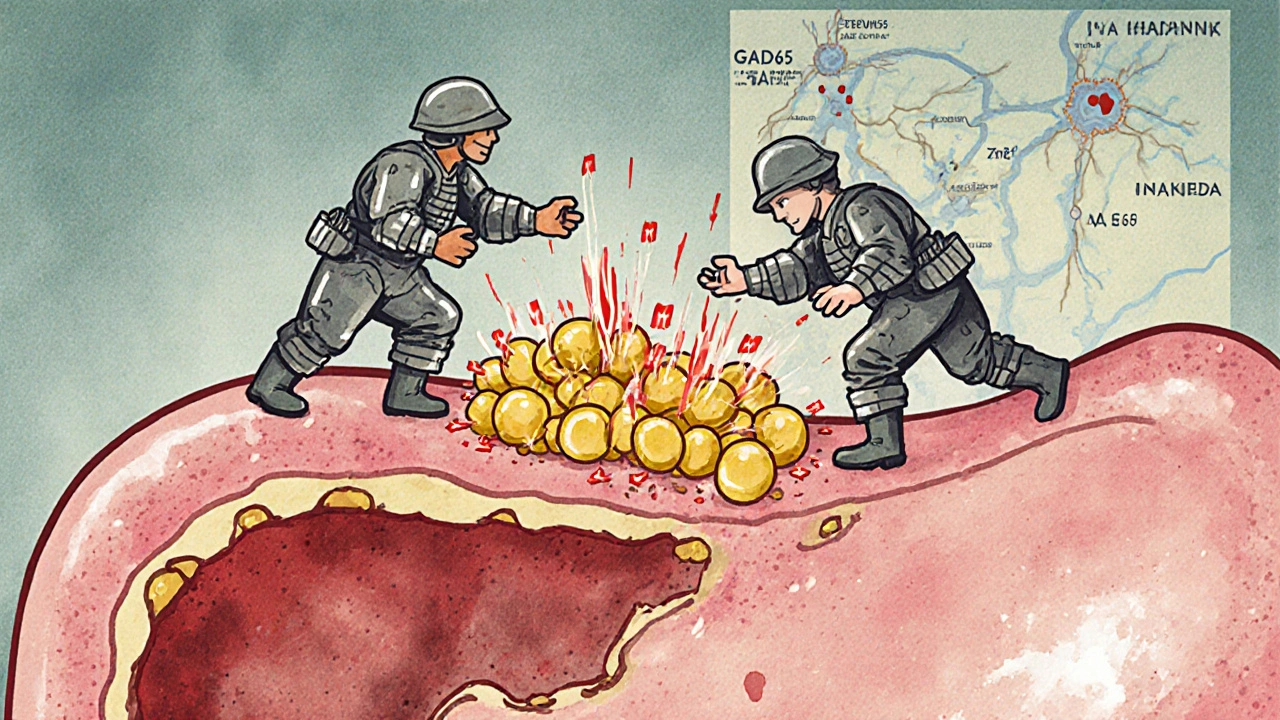Type 1 diabetes isn’t just about high blood sugar or needing insulin shots. It’s a silent, ongoing attack by the body’s own immune system on the insulin-producing cells in the pancreas. This isn’t a lifestyle issue. It’s not caused by eating too much sugar. It’s an autoimmune disease - the same category as multiple sclerosis or rheumatoid arthritis - but focused entirely on the pancreas. And if you or someone you know has been diagnosed, understanding this truth changes everything about how you manage it.
What’s Really Happening in the Pancreas?
Inside a healthy pancreas, tiny clusters of cells called islets produce insulin. These are the beta cells. In type 1 diabetes, the immune system mistakes them for invaders. T-cells swarm in, triggering inflammation known as insulitis. They target specific proteins on the beta cells - insulin itself, GAD65, IA-2, and ZnT8. Over weeks, months, or even years, these cells are destroyed. By the time someone feels thirsty, tired, or loses weight, they’ve already lost 80-90% of their insulin-making capacity.
At diagnosis, most people have C-peptide levels below 0.2 nmol/L. That’s the body’s own insulin signature. Without it, you can’t regulate blood sugar. This isn’t a matter of willpower. It’s biology. And unlike type 2 diabetes, where the body resists insulin, type 1 means you have almost none left.
It Starts Long Before Symptoms Show
There are three stages to type 1 diabetes - and most people don’t know they’re in stage one or two until it’s too late.
- Stage 1: Two or more autoantibodies are present, but blood sugar is normal. This happens in about 0.4% of the general population - often kids with a family history.
- Stage 2: Blood sugar starts to rise, but no symptoms yet. Around 0.15% of people reach this point. Their bodies are struggling to keep up.
- Stage 3: Symptoms appear - weight loss, frequent urination, extreme thirst. This is when insulin becomes life-saving.
Children progress faster. From first autoantibody to diagnosis, it takes about 2.8 years on average. Adults? Up to 12.7 years. That’s why some adults are misdiagnosed with type 2 - they’re still making a little insulin, so doctors assume it’s insulin resistance. But if their C-peptide is low and they have autoantibodies, it’s type 1. Misdiagnosis happens in 12% of adult cases, and that delay can be dangerous.
Why Genetics and Environment Both Matter
You don’t get type 1 diabetes by accident. Genetics load the gun. Environment pulls the trigger.
Over 50 genes are linked to risk, but the biggest one is HLA-DR3/DR4. People with this combination have a 20-30 times higher chance of developing type 1 than those without it. But not everyone with these genes gets the disease. That’s where environment comes in.
Enteroviruses - especially coxsackievirus B - show up in the blood of kids months before diagnosis. Studies show a 58% higher risk when these viruses are detected. Other possible triggers? Vitamin D deficiency, early exposure to cow’s milk, and even gut bacteria changes. One 2022 study found that people with type 1 have less Faecalibacterium prausnitzii - a good gut bug that helps calm inflammation. No one knows for sure yet, but the gut-pancreas connection is real.

It’s Not Just the Pancreas - Autoimmune Pancreatitis Can Show Up Too
Most people think type 1 diabetes only affects the endocrine part of the pancreas - the islets that make insulin. But the pancreas also has an exocrine side, which makes digestive enzymes. In rare cases - about 1 in 300 people with type 1 - the immune system attacks both.
This is called autoimmune pancreatitis (AIP). It causes swelling, pain, and digestive problems. It’s often misdiagnosed as pancreatic cancer. Diagnosis requires three things: imaging changes, elevated IgG4 blood levels, and tissue biopsy. Type 1 AIP responds well to steroids - 95% of patients improve within a month.
But here’s the catch: steroids raise blood sugar. So if you have both type 1 diabetes and AIP, your insulin needs can spike overnight. You need endocrinologists and gastroenterologists working together. The American Diabetes Association now recommends checking for pancreatic enzyme deficiency in type 1 patients with ongoing bloating, diarrhea, or weight loss - it affects 5-10% of long-term patients.
Current Treatment: More Than Just Insulin
Insulin is non-negotiable. But how you take it matters more than ever.
The standard is multiple daily injections (MDI) or an insulin pump. Most people use rapid-acting insulin (like aspart or lispro) before meals and long-acting (like glargine U-300) for background coverage. The ADA recommends starting with 0.5 units per kilogram of body weight per day - split evenly between basal and bolus.
But insulin alone isn’t enough. You need to know your numbers in real time. Continuous glucose monitors (CGMs) like the Dexcom G7 don’t just track sugar - they predict drops. The 2023 DIAMOND trial showed CGMs lower HbA1c by 0.4-0.6% and cut low-blood-sugar events by half.
Even better? Closed-loop systems - or “artificial pancreas” devices like Tandem’s Control-IQ. These link your CGM to your pump and automatically adjust insulin. In a 2022 JAMA study, users spent 71-74% of the day in target range. People on MDI? Only 51-55%. That’s not a small difference. It’s life-changing.
The First Disease-Modifying Drug: Teplizumab
For decades, we only treated symptoms. Now, we can delay the disease.
In November 2022, the FDA approved teplizumab (Tzield) - the first drug that changes the course of type 1 diabetes. It doesn’t cure it. But for people in stage 2 - with autoantibodies and rising blood sugar but no symptoms - it delays diagnosis by nearly 2.5 years on average.
How? It targets immune cells that attack beta cells. It’s given as a 14-day IV infusion. Side effects include temporary drops in white blood cells and rash. But for families with a child who tests positive for multiple autoantibodies, this is a game-changer. It’s not a cure. But it buys time - time to prepare, to learn, to adjust.

What’s Next? New Therapies on the Horizon
Research is moving fast.
- Stem cell islets: Vertex Pharmaceuticals’ VX-880 trial gave insulin independence to 89% of 12 participants within 90 days. It’s still experimental, but it’s real.
- Verapamil: A common blood pressure drug. In a 2022 trial, it preserved 30% more insulin production in newly diagnosed adults.
- Abatacept: An arthritis drug that blocks T-cell activation. In TrialNet, it slowed C-peptide decline by 59% over two years.
The future isn’t just insulin. It’s immunotherapy + beta-cell support. The 2024 ADA/EASD guidelines call this the “next frontier.” We’re moving from managing blood sugar to protecting what’s left of the pancreas.
Cost and Access: The Hidden Burden
Living with type 1 diabetes costs about $19,743 per year in the U.S. Insulin alone makes up $9,601 of that. Even with insurance, many people ration insulin because they can’t afford it. The price of rapid-acting analogs is 3-5 times higher than human insulin - and there’s no generic version.
CGMs and pumps are expensive too. Medicare and many insurers cover them, but not always without hurdles. And teplizumab? It costs over $100,000 per course. Access is still limited.
This isn’t just a medical issue. It’s a systemic one. And until pricing and coverage improve, many people will struggle - no matter how well they understand their disease.
Final Thought: You’re Not Just Managing Blood Sugar
Type 1 diabetes is an autoimmune disease of the pancreas. That means your immune system is the enemy - not your diet, not your weight, not your choices. The goal isn’t perfection. It’s survival. It’s stability. It’s protecting what little beta-cell function you have left.
Use the tools: CGMs, pumps, insulin, teplizumab if eligible. Learn about gut health. Watch for signs of autoimmune pancreatitis. Ask about clinical trials. You’re not alone - 1.25 million Americans live with this. And science is catching up.
The future of type 1 diabetes isn’t about more insulin. It’s about stopping the attack before it destroys everything.



Comments
It’s not about willpower. It’s biology. And that’s the only thing that matters now.
Everything else is noise.
Oh wow, another post that treats type 1 like it’s a TED Talk and not a daily hell of finger pricks and panic lows.
Congrats, you just monetized suffering with big words.
I’m so glad this exists. I’ve been trying to explain to my family that this isn’t ‘eating too much candy’ for years.
Teplizumab giving us time? That’s hope. Real hope.
Thank you for writing this.
The notion that autoimmune destruction is somehow ‘silent’ is a linguistic illusion. It’s not silent-it’s screaming in C-peptide levels, in ketones, in the trembling hands of a 14-year-old at 3 a.m. who just realized their glucose dropped 80 points in 12 minutes. The pancreas doesn’t whisper-it implodes. And the medical system still treats it like a minor inconvenience with a pill.
What we need isn’t more jargon about beta cells. We need a complete overhaul of how society perceives chronic autoimmune disease-as a disability, not a lifestyle choice wrapped in a glucose monitor.
And yet, here we are, talking about insulin dosing like it’s a spreadsheet and not a life-or-death algorithm running on a body that’s been hijacked.
Very well explained. I’ve seen this in my cousin-he was misdiagnosed as type 2 for 18 months. By then, his C-peptide was nearly gone.
Doctors need to test autoantibodies earlier, especially if there’s family history.
Thanks for the clarity.
Stop acting like teplizumab is some miracle cure. It delays diagnosis by two years. That’s not a win-it’s a delay of the inevitable. And at $100K? You’re selling hope to desperate parents while the system keeps insulin at $300 a vial.
Real talk: this is capitalism with a stethoscope.
I just want to say I read every word of this. I have a friend who was diagnosed at 22 and now has autoimmune pancreatitis on top of it. She never told anyone because she thought no one would understand.
When you mentioned the digestive issues and enzyme deficiency, I cried. No one talks about that part. The bloating, the floating stools, the fear that it’s cancer again.
Thank you for naming it. She needs to see this.
Teplizumab = $100K
Insulin = $300/vial
CGM = $1000/month
Me: 🤡
Man, I didn’t even know about autoimmune pancreatitis in type 1. That’s wild.
And the gut bacteria thing? Makes so much sense now why probiotics helped my cousin so much.
Maybe we’re all just one big microbiome experiment gone sideways.
Either way, thanks for the deep dive. This stuff matters.
It’s fascinating how the immune system’s targeting of ZnT8 and GAD65 is so precise-it’s like the body has a molecular map of the pancreas, and somehow, in a genetic lottery gone wrong, it’s been rerouted to self-destruct. And yet, we still don’t know why it starts. Is it a virus? A leaky gut? A vitamin deficiency? A combination? The science is moving fast, but the questions are multiplying faster.
And while stem cell islets are promising, they’re not a cure if the immune system just attacks the new cells too. That’s the real hurdle: not replacing the pancreas, but retraining the immune system to stop seeing it as a threat.
Teplizumab is a band-aid on a bullet wound, but it’s the first band-aid that actually slows the bleeding. That’s not nothing. It’s a beginning.
And we need more of them-faster, cheaper, accessible. Because waiting for perfection means letting people die while we debate the ethics of a cure.
This article is overly verbose and emotionally manipulative. Type 1 diabetes is a medical condition. It does not require poetic language or dramatic framing. Insulin is the treatment. End of story.
Stop romanticizing suffering.
My kid got diagnosed at 6. We started teplizumab last year.
Two years of breathing room? Worth every second.
And yes, I cried reading this. 😔